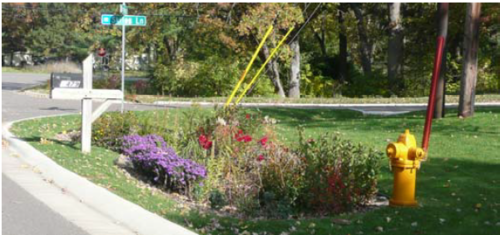
MS4 fact sheet - Establishing An Infiltration Standard
Contents
Establishing An Infiltration Standard
Creating an infiltration standard for development and redevelopment
Infiltration is a highly effective stormwater practice that reduces runoff volume, increases ground water recharge, improves surface water quality, provides thermal benefits and helps to mimic predevelopment hydrology. While other practices may address stormwater quality and rate control, limiting increased volumes of runoff from development and redevelopment is the most effective way to reduce the cumulative impacts on downstream water resources.
This fact sheet addresses effective tools and strategies to assess existing ordinances and develop consensus for the adoption of an infiltration standard. In addition, this fact sheet includes discussion on the importance of mimicking natural or predevelopment hydrology, and provides a range of example infiltration standards adopted across the state with links to example municipal ordinances and watershed district rules. Benefits / Pollution Reduction
The main goal of an infiltration standard is to mimic the natural hydrology of the landscape by allowing water to soak into the ground close to where it falls. This generally means defining an infiltration standard that limits post-development runoff volume to pre-development runoff volume. The multiple objectives that can be realized with infiltration (volume control) as part of a stormwater management plan include:
- Reduced stormwater pollutants
- Increased ground water recharge
- Decreased runoff volume and peak flow rates
- Preserved base flow in streams
- Reduced thermal impacts of runoff
- Lowered infrastructure costs
Program Development & Implementation
The Right Infiltration Standard for Your MS4=
The infiltration standard of your MS4 should be based primarily on the local geology/soils, existing and planned land use, stormwater goals and stakeholder interests. Attaining a balance among these sometimes competing interests will determine what infiltration standard is feasible.
- Geology/soils – Defines the infiltration rates and connectivity of the predevelopment landscape. MS4s that contain diverse geology should implement a pre-to-post development event standard. Homogeneous landscapes may be able to implement a flat standard for the entire MS4. Note that although some level of infiltration can occur in any soil, other volume reduction techniques might be better when extremely low infiltration rates prevent achieving a community’s volume reduction goal.
- Existing and planned land use – A fully developed MS4 will want to focus on retrofit and redevelopment stormwater standards, whereas new construction infiltration standards should be the focus of a developing MS4.
- Stormwater goals –Stormwater issues need to be defined and the infiltration requirement should be tailored to address these issues. Water quality and quantity can be addressed partially, if not fully, through infiltration practices.
- Stakeholder Interests – Working with all stakeholders in the MS4 to garner support for any ordinance is very important to its success. The best approach is to get feedback early and often and work through any issues or misconceptions that may exist.
Infiltration Standard Categories
Infiltration standards vary across the state based on the factors previously discussed. Watershed Districts, Municipalities and Water Management Organizations all enact standards that are designed to protect their waters. The standards generally fall into two categories: flat standards and pre-to-post standards.
Flat standards Flat standards are typically expressed as the volume of runoff generated by a certain rainfall depth, typically 0.5- or 1.0-inch. These standards are usually applied only to impervious surfaces, either net additional impervious or total impervious. Net additional impervious is calculated by subtracting the total area of existing impervious area from the impervious area under post construction conditions. Total impervious is the total impervious area under post construction conditions. Some standards may also only apply to areas draining to special water such as trout streams, or may include rainfall over the pervious areas of the site as well as the impervious areas. Flat standards do not mimic existing condition hydrology as precisely as a pre-to-post standard, but are considered by most practitioners to be more easily implemented.
Pre-to-post standards Pre-to-post standards require modeling of existing runoff volumes and hold post-development runoff volumes to existing conditions for a return frequency rainfall event, typically the 1- or 2-year storm event. In other words, pre-to-post standards restrict the volume that leaves the site after development, keeping it equal to predevelopment conditions. This requires more in-depth development review, but also provides a better analysis of the land than a flat standard. This method more reliably mimics existing conditions, better protects downstream resources and avoids over- or under-applying a flat infiltration standard.
Example Infiltration Standards
The following table is a sampling of infiltration requirements for development/redevelopment within the Twin Cities Metropolitan Area (2009). Flat standards are the most prevalent due to the ease of application. Pre-to-post standards are also utilized, particularly in locales that have unique geologic setting and resources of high value.
Example Infiltration Requirements in the Twin Cities Metro Area (2009)
